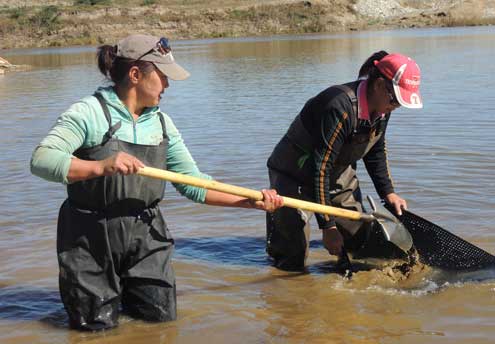Since the collapse of the socialist regime in 1990, Mongolia’s economic development has been dependent on an expanding formal and informal mining sector that for many years had little regard for the environment. As the negative environmental implications of such rampant mining expansion became clearer, Mongolia’s government and national and international communities have put pressure on mining companies to comply with international environmental standards. Such pressure has driven progress in the large-scale mining sector to invest greater resources to reduce their impact with significant attempts to comply with international environmental standards, including performance standards specified by key lending banks.

Mongolia’s government and national and international communities have put pressure on mining companies to comply with international environmental standards. Such pressure has driven progress in the large-scale mining sector to invest greater resources to reduce their impact with significant attempts to comply with international environmental standards.
However, for the estimated 100,000 small-scale artisanal miners who work independently and make up nearly 20 percent of Mongolia’s rural workforce, complying with these standards is complicated at best.
Historically, artisanal miners have been marginalized from society due to the negative impact of their mining activities on the environment. This has prevented them from achieving their full economic potential and from developing more sustainable environmental practices. However, thanks to government efforts and an increase in awareness, that negative perception is shifting, and Mongolia’s artisanal miners are gradually becoming more formalized and are being recognized as important contributors to the economy.
In 2010, the government legalized artisanal mining as an official occupation, recognizing the rights of artisanal miners to work, mine land, and organize themselves into official partnerships. Today, these workers contribute $110 million annually to export revenues. Their rights, however, have often conflicted with the rights of communities living close to artisanal mining sites, especially the communities’ right to be protected against environmental pollution and ecological imbalance (as defined in Article 16.2 of the Constitution of Mongolia). As many rural communities depend on natural resources for jobs and food, environmental degradation can destroy traditional livelihoods.
Given that artisanal miners often lack access to knowledge, financial resources, and technological capacity, it has been very difficult to implement environmentally friendly practices in relation to rehabilitation of degraded land. Such mining impacts the interests of other stakeholders in the community, where large unfilled shafts, compacted soils, loss of vegetation and topsoil, and polluted water degrade the value of pasturelands and impact wildlife. As such, artisanal mining communities have often been excluded from local decision-making processes.

There are an estimated 100,000 small-scale artisanal miners in Mongolia who work independently and make up nearly 20 percent of the country’s rural workforce. Photo/Marieke Heemskerk
Since 2006, The Asia Foundation has been working with Mongolia’s artisanal mining sector on sustainable local development through its Engaging Stakeholders in Environment Conservation project. The project introduces responsible and sustainable environmental rehabilitation approaches for abandoned artisanal and small-scale mining sites. The work engages a range of stakeholders – from local communities and artisanal miners, to local officials, businesses, and civil society – and incorporates a human rights based approach (HRBA), which focuses on strengthening participation of all stakeholders in local development and environmental decision-making processes.
In 2010, we partnered with 19 local environmental NGOs to establish over 20 multi-stakeholder councils (LMCs). This year, local environmental NGOs conducted HRBA training in over 15 soums (local districts) involving artisanal miners, local communities, mining companies, and local governments to enhance their knowledge and understanding about respective rights and responsibilities. Trainings focused on local decision-making processes on socio-economic development and effective environmental rehabilitation of artisanal mining sites.
The interactive training sessions clarified roles and responsibilities of “duty bearers” and “rights holders.” These include the duty of local governments to create opportunities for meaningful participation and to empower vulnerable groups such as artisanal miners to be part of local decision-making processes. They also highlighted the right of citizens to participate in decisions affecting them and to hold local governments accountable for securing such rights.
As part of the HRBA training, participants identified the key human rights challenges in their communities as well as their root causes. In many areas, persistent unemployment was identified as a key human rights violation of the right to work resulting in people being forced to engage with the informal artisanal mining sector. It became clear that most soums do not have clear policies to address this issue nor are investments made to promote the creation of sustainable jobs. Local governments were therefore encouraged to develop such a policy with HRBA as an integral part of the process.
To complement the HRBA trainings, the project initiated frugal rehabilitation of degraded land, which is an economically affordable, socially acceptable, and ecologically viable rehabilitation approach, at eight sites involving 355 artisanal miners, with rehabilitation completed by artisan mining communities themselves. If local governments recognize such skills as legitimate forms of employment, then frugal rehabilitation can not only help shift the perspectives of artisanal miners on their responsibilities to the community, but can also create opportunities for green jobs for local communities, addressing both poverty and unemployment as well as rehabilitation of degraded lands. From a human rights perspective, addressing the economic rights of artisanal miners, while also fulfilling citizens’ rights to live in a safe and healthy environment, is essential.
Bolormaa Purevjav is senior advisor to The Asia Foundation’s Engaging Stakeholders in Environmental Conservation Project(ESEC II) funded by the Swiss Agency for Development and Cooperation. The ESEC II project complements SDC’s Sustainable Artisanal Mining project. P. Bolormaa can be contacted at bolormaa.purevjav@asiafoundation.org. The views and opinions expressed here are those of the individual authors and not those of The Asia Foundation.